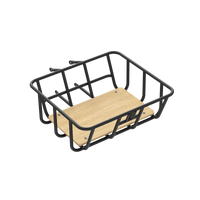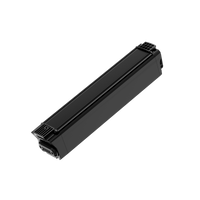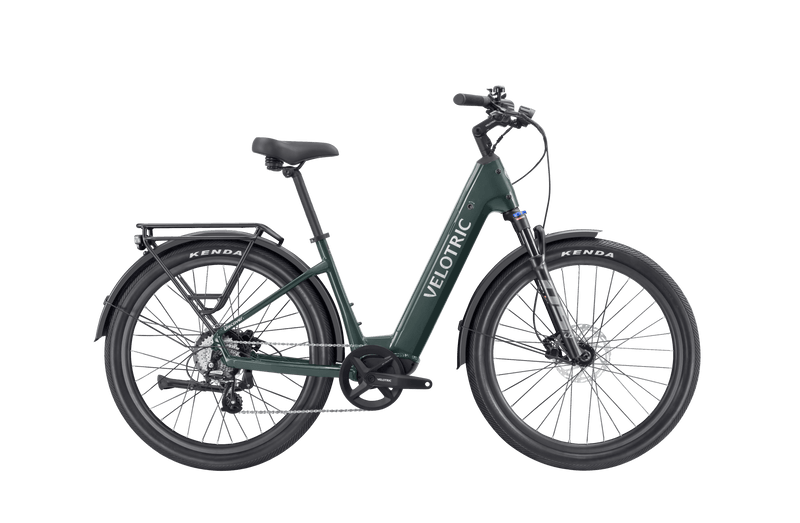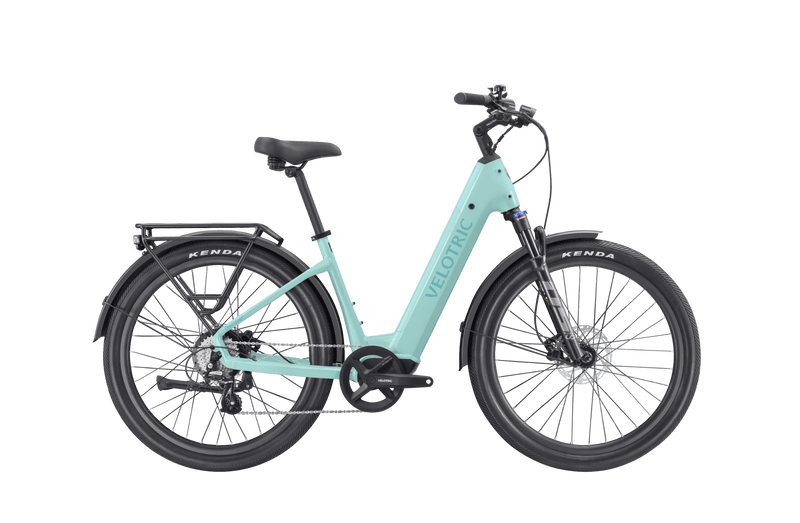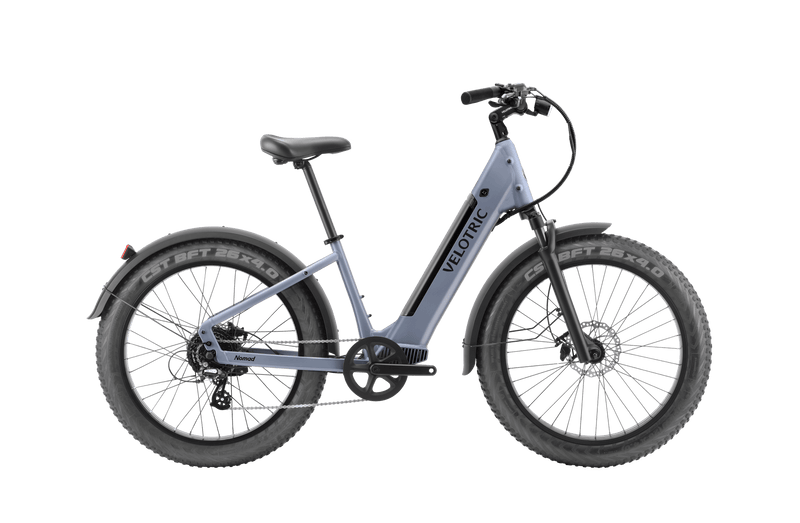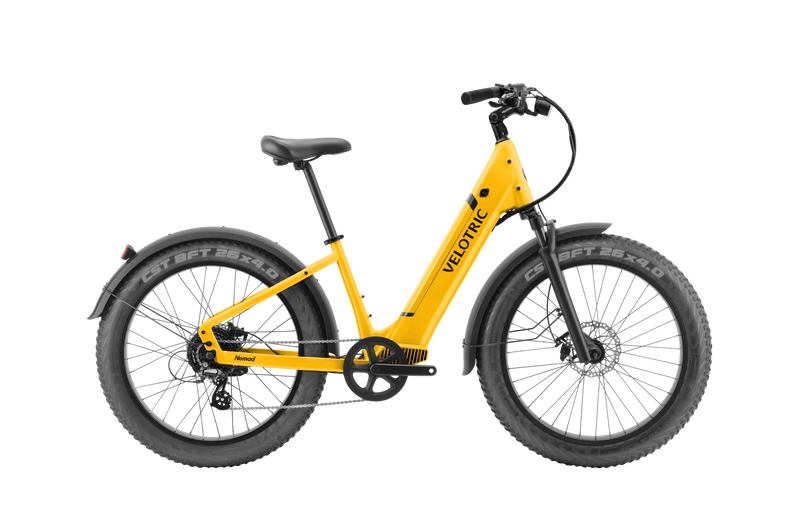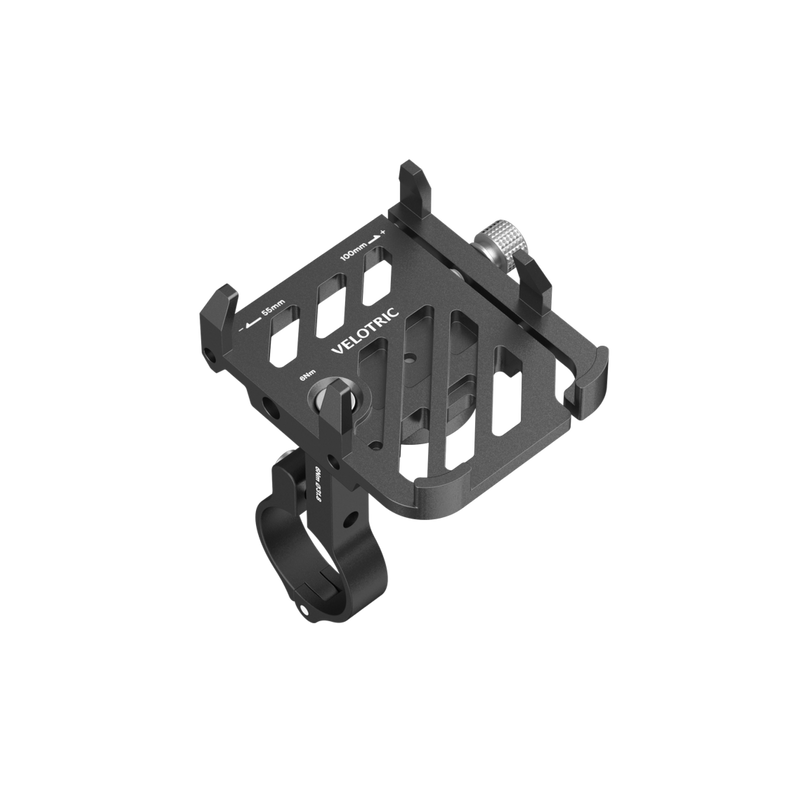Your bike’s tires are a lot like a pair of shoes: They help your bike get from point A to point B, offering support and protection and ensuring you can enjoy a smooth ride.
That said, there are several types of bike wheels to choose from, and picking the right tires can be as tricky as picking the perfect pair of shoes for your outfit.
Fat tire bikes have become especially popular lately — and for good reasons. With tires that are wider than the average road or commuter bike, fat tire bikes offer better traction and stability and are well-suited to all kinds of weather conditions.
Below, we go into greater detail about the benefits of fat bike tires so you can decide if they’re the right wheel size for you.
About fat road bike tires
Before we start touting the benefits of fat road bike tires, let’s establish what we mean by a fat tire. Put simply, fat tires have a larger diameter and width than standard road bike or commuter bike tires.
A road bike tire is usually ultra-thin to reduce friction and increase speed. These tires usually don’t measure more than 23 to 25 millimeters (for reference, 25 mm is a little less than one inch). Commuter bike tires usually have wheels that are a little wider, about 28 to 42 mm.
Now, a fat tire bike has a tire width of anywhere from 80 to 100 mm — more than twice as much. That’s equal to an approximately 3- to 4-inch tire. Fat tire bikes also tend to have a larger diameter than road or commuter bikes. Newer fat tire bikes generally have an inner tube diameter of about 26 to 27.5 inches.
When it comes to tread, fat tire bikes offer all varieties. You can find wide tires with deep treads for rough terrain or wide tires with smoother treads for paved surfaces. There are even studded fat bike tires (studs help the bike grip icy surfaces).
In short: Consider where you’ll be riding when picking your tire tread.
Another consideration is threads per inch (TPI), which lets you know how fine the fabric is that’s used to make the tire casing. For example, a 120TPI tire will be more robust than a 60TPI tire.
What are the benefits of fat road bike tires?
So, now you know what makes a fat tire fat — but just what does that added diameter and width do for you as a cyclist? Here’s what to expect.
Traction
Fat tire bikes have a larger surface area thanks to their increased width, so they make more contact with the road. This results in greater traction, enhancing stability and reducing the risk of slips.
Add a deep tire tread to the mix, and the bike’s ability to grip the ground is even greater. For this reason, fat tire bikes can be great for off-road experiences and riding on surfaces like grass, gravel, dirt, and sand.
Comfort
Another advantage of fatter tires is that they can absorb more impact, which is especially important if you’re taking your fat tire e-bike on bumpy rides or unpaved trails. You don’t want to feel a jolt every time your bike goes over a root or rock, and fatter tires can help.
Hint: You’ll only get the maximum comfort offered by fat tires if they’re properly inflated. Check your tire pressure regularly. Our e-bike maintenance guide covers how to check for and deal with low pressure and other basic upkeep.
Fat tires can also be more comfortable because they’re more stable. The bike is less prone to tipping over because it has larger wheels to stand on. This can be especially comforting for novice cyclists and kids.
Weather conditions
If we lived in a perfect world, the sun would be shining every time you took your e-bike out for a ride. But let’s face it: You might be stuck riding on days when it’s windy or raining.
A fat tire bike can be a big boon in these weather conditions. The added stability of fat tires can be beneficial in holding up against a gust of wind, for example. Meanwhile, the traction of a fat tire bike can help prevent skids on slick surfaces.
Safety
The above features — traction, comfort, and weather versatility — also make a fat tire bike safer. The added traction helps prevent slipping, for example. This lets you ride with peace of mind.
The enhanced safety offered by a fat tire bike can be especially useful for beginners. Children learning to master two wheels or adults who are feeling unsteady will appreciate the added comfort of a fat tire ride.
Fun
All practicalities aside, riding a fat tire bike is a lot of fun. Thanks to the added traction, comfort, and safety it offers, your fat tire bike will open up a world of possibilities in terms of where and when you cycle.
With fatter tires, you’re no longer restricted to riding on paved areas like bike lanes and city streets. You can take your fat tire bike into parks and on trails (as permitted). Do you need some inspiration? Check out our roundup of some of the best bike trails in the United States.
Who do fat road bike tires benefit?
Given their benefits, it’s no wonder fat tire bikes are gaining traction (pun intended).
Fat tires are manufactured by major names like Surly, Schwalbe, Kenda, Vanhelga, Wrathchild, Flowbeist, Wrathlorde, Vee Tire, Jumbo Jim, Maxxis Minion, Juggernaut, Hüsker Dü, and FBF.
Wider tires aren’t exclusively for any one person or type of cyclist. Anyone can enjoy riding a bike with fatter tires. That said, some of the benefits described above — like added traction, stability, and safety — might be appealing to beginner cyclists or kids.
However, it’s important to note that fat tire bikes aren’t right for all types of cyclists and purposes. For example, someone planning to take up road racing shouldn’t purchase a fat tire model.
Instead, opt for slim road tires, which reduce friction and rolling resistance — turning you into a true speedster.
Similarly, a fat tire bike isn’t a replacement for a mountain bike (MTB). Mountain bikes have other features, like enhanced suspension, that make them suitable for a pro mountain biker’s aggressive riding style.
Mountain bike tires also have deeper treads, which are great for steep descents, hill climbing, and jumps.
In short: Trying to use a fat tire bike on a mountain bike trail would be like trying to conquer a snowshoe trail in sneakers. Not advisable!
Fat road bike tire FAQs
Do you still have questions about fat tire road bikes? We’ve answered some of the most common questions about the topic below.
Can you put fat tires on a standard road bike?
No, it’s generally not possible to equip a standard road bike with fat tires. This is because the larger tires need more clearance within the bike wheel’s forks. You need a fat-tire bike to accommodate wider tires.
Are fat tire bikes harder to pedal?
Fat tire bikes create more friction with the ground, increasing rolling resistance. This means they require a bit more pedaling than a road bike — but you likely won’t notice a major difference as an everyday cyclist.
Are fat tire bikes easier to balance and control?
Yes, the wider tires add stability, making it harder for the bike to tip over and easier for the cyclist to control it.
Discover why the Velotric Nomad 1 fat tire e-bike is so popular
Bigger doesn’t always mean better. However, when it comes to bike tires, fat tire bikes do have some distinct advantages.
If you’re looking for a quality fat tire e-bike, consider Velotric’s Nomad 1. It comes in both high-step and step-through models (learn the difference between the bike frame types).
In addition to its wide tires, the Nomad 1 features an ergonomic seat, five-level pedal assist, and throttle assist — making for a comfortable ride. You can also expect safety features like hydraulic disc brakes, front and rear lights, and reflectors.
Velotric’s bike frames have been tested more than 150,000 times, and our lithium-ion batteries are certified by Underwriters Laboratories (UL2271), giving you quality you can count on.
Try one of our fat tire bikes for yourself. Find a bike shop with Velotric in stock and book a test ride today.























